
©1999-2003. All rights reserved.

|
Scenic Materials


MATERIALS
 Sisal string
Sisal string

| This coarse fibre string can be cut up for making long grass and reeds
up to an inch high, or for thatching buildings
(although in this use the twisting can create an unwelcome ripple even
when unwound.)
This ball is one of a pair that I got from an everything's £1 shop.
|
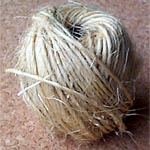
|
Usefulness - Good for reeds and grass, reasonable for thatching.
Availability - Fairly Common.
Sources - Hardware stores.
 Masking Tape
Masking Tape

Masking tape is a yellowy tape with a relatively weak adhesive. It is usually used for masking off areas when interior decorating. Its most useful modelling function is folding it over wire to make leaves. A strip of it can also be used to cover the unsightly corners of foamboard buildings before painting them.
Usefulness - Foliage, foam card edging.
Availability - Common.
Sources - Hardware stores, art and stationary shops.
 Balsa Wood
Balsa Wood

Balsa is a very soft wood that is easy to cut and carve, so it is ideal for any model with
wooden components. It is sold in a variety of forms such as rods, or sheets of various
thicknesses. Unfortunately it is relatively expensive.
Usefulness - Very useful for all wooden objects.
Availability - Common.
Sources - Model shops.
 Plywood
Plywood

Plywood is made of thin layers of wood stuck together with glue. The most useful plywood is the thinnest (less than 2mm or about 1/16 of an inch), but it still hasn't got many uses in modelling.
Although it is very strong and stiff, it is hard to cut and tends to splinter at the edges. Generally mounting card is a better alternative as it is cheaper and easier to work.
Usefulness - Good strong bases
Availability - Fairly Common.
Sources - Model & craft shops.
 Bamboo Skewers
Bamboo Skewers

These are strong poles which can be used as fenceposts, or even as scaffolding poles for modern/sci-fi (the wooden texture is fairly minimal).
They are sold in large cheap packs by supermarkets for barbecuing kebabs etc.
Usefulness - Good strong fence posts or scaffolding
Availability - Common.
Sources - Supermarkets.
 Broom Head Fibres
Broom Head Fibres

|
Very good for long grass and thatched roofs.
These broom heads are surprisingly cheap (about £1.50 from Wilkinsons) and contain a huge amount of fibre. Make sure you get natural coco fibres and not plastic, which won't glue or paint up so well.
|
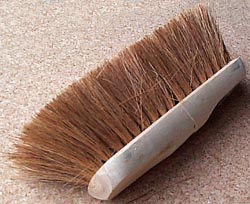
|
Usefulness - Good for grass and thatching
Availability - Common
Sources - Hardware shops
 Lichen
Lichen

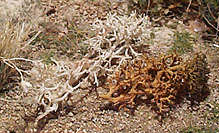 One
of the most common types of foliage is reindeer lichen. This comes dyed in
a variety of colours, several greens, orangey brown and a pale cream colour.
It is a soft spongey texture, and can easily be torn into small pieces and
glued with PVA. Don't get it wet or it will
dry hard and brittle. One
of the most common types of foliage is reindeer lichen. This comes dyed in
a variety of colours, several greens, orangey brown and a pale cream colour.
It is a soft spongey texture, and can easily be torn into small pieces and
glued with PVA. Don't get it wet or it will
dry hard and brittle.
It is sold in most modelshops, although it can be cheaper from florists.
The cheapest I have ever seen it is in the craft section of a 'Do-It-All'.
Usefulness - Excellent foliage
Availability - Common.
Sources - Model shops, florists, craft sections of DIY stores.
 Loofah
Loofah

|
Normally used for scrubbing yourself in the bath, this can be used for foliage, but it is rather expensive and tough to cut. The spine of the loofah looks rather peculiar and might be good for organic scenery in Giger 'Aliens' style. Recently on holiday in Greece, I saw some large less dense loofahs, which would be much better than those available in the UK.
|
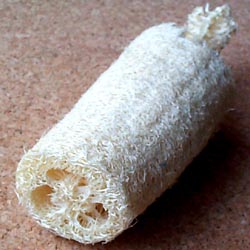
|
Usefulness - Vaguely useful for foliage
Availability - Fairly Rare
Sources - Shops selling bath products
 Rubberised Horsehair
Rubberised Horsehair

| Rubberised horsehair is an excellent material for producing foliage.
Unfortunately it is very difficult to get hold of, your best chance is
a quality upholsterers, or maybe your granny's old sofas.
The type shown here has a very circular pattern to its hairs, but there is a slightly better type which is more spiky.
|
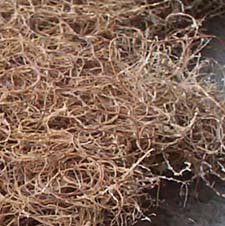
|
Usefulness - Excellent for foliage
Availability - Very Rare
Sources - Upholsterers
 Fake Fur
Fake Fur

| Nylon fur can be bought from a good department store like John Lewis. It cost about £3.50 per square
metre, so it's very cheap. Cut it into small irregular pieces, and it makes good long grass. It can be painted
by watering down acrylic or emulsion, blobbing it on the back of the material and then rubbing it through
with your finger. Don't use too much or the paint will stick the fibres together in nasty matted clumps.
Using patches of different colours will help get a natural look.
The only disadvantage is that the weave of
the backing is sometimes visible. At the edges of the material this can be disguised with flock.
|
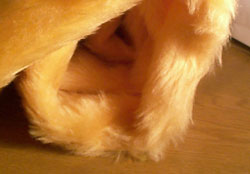
|
Usefulness - Long grass
Availability - Common
Sources - Department stores
 Plumber's Hemp
Plumber's Hemp

| Plumber's hemp can be used for thatching buildings. Broom
head fibres can be easier to use, but only on straight sided not conical
roofs. Hemp has been used for the roof of this hut.
|
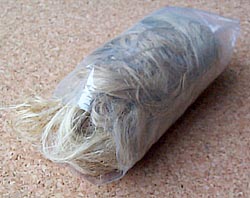
|
Usefulness - Vaguely useful for thatching
Availability - Fairly Rare
Sources - DIY shops
 Card
Card

Thin card has a multitude of modelling uses, and is one of the cheapest materials.
You can get it from the back of pads of paper, inside reinforced envelopes etc. Get into
the habit of never throwing away a good piece of card, and you won't need to buy any.
Cereal packets and other food packaging can also be a source, but the card tends to be a
bit flimsy, and the painted side doesn't take paint well.
Usefulness - All sorts of odds and sods
Availability - Common
Sources - Art & craft shops, various
 Mounting Board
Mounting Board

This is a very heavy card about 1.5mm thick. It comes in a variety of sizes and
textures, and is excellent for making buildings and small bases. It can warp slightly
when painted or glued.
Usefulness - Vital for bases, walls etc.
Availability - Common
Sources - Art & craft shops
 Foam Card
Foam Card

Also known as foam board or kappa board, this is a sheet of foam between two thin
bits of card. It is usually about 5mm thick and does not warp too easily. Although it
is easy to cut, you will need to use a very sharp blade to get a clean cut and avoid ripping the foam.
Usefulness - Good for bases, and masonry walls.
Availability - Common
Sources - Art, craft & model shops
 Hardboard
Hardboard

If you are looking for something substantial to base small items of scenery, then
hardboard is the stuff you need. It's made by pressing pulped wood with some kind
of adhesive into sheets about 3mm (1/8") thick. Although the 2100x2400mm (4'x8') sheets that
it generally comes in seem very
flexible, by the time it has been cut down to the sort of size that you might use
for bits of scenery, it's a very strong and rigid base material.
Usefulness - Excellent for bases
Availability - Common
Sources - DIY shops
 Plastic Card
Plastic Card

Plastic card is a thin sheet of the same plastic that is used for
model kits. It can be glued with polystyrene
cement and comes in a variety of thicknesses from little more than heavy
paper up to about 2mm. It is fairly expensive, and costs 50p to £1.50
per A4 sheet depending on the thickness. Usually standard card can be used instead,
but plastic card can give a fairly neat finish because it will not delaminate.
Usefulness - Scratch built vehicles and ponds
Availability - Common
Sources - Model shops
 Phone wire
Phone wire

Phone wire is a thin solid strand enclosed in plastic insulation. Often several wires are twisted
and enclosed in a single cable. It has many uses in scratch building, including plant stems,
such as these palm trees.
Most of my phone wire has come from finding it on the street. Around nearly every roadside telecom
junction box. (I don't know the proper name for them - they are about 4' high, 3' long and 1' deep),
you will find clippings of wire, where the
engineer has carried out changes and dropped the offcuts.
Usefulness - Various scratchbuilding
Availability - Common
Sources - DIY stores, electronics shops & the street
 Car Body Repair Mesh
Car Body Repair Mesh

This is a fine diagonal aluminium mesh which can be easily cut with ordinary scissors. It is ideal for sci-fi
scenery and basing figures. It can also be used to make barbed wire.
Usefulness - Versatile for sci-fi, also for leaded window effect
in medieval buildings.
Availability - Common
Sources - DIY, car parts and model shops.
 Aluminium Grid Mesh
Aluminium Grid Mesh

This stuff is useful for sci-fi buildings and fences.
It is available in a couple of sizes, such as 6mm and 12mm squares. It is often sold in pet shops to make cages from.
Usefulness - Moderately useful for 25mm sci-fi/modern
Availability - Fairly Common
Sources - DIY and pet shops.
 Net Curtain Material
Net Curtain Material

A very fine fabric mesh that can be used for textures on scenery. Stick it down with watery PVA.
I have used it for the surface on this walkway. You will need a really sharp
scalpel blade or scissors to cut it without tearing.
Usefulness - Useful for sci-fi gratings, also 6mm fencing.
Availability - Fairly Common
Sources - Fabric shops or market stalls.
 Lining
Lining

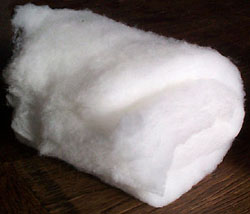 A sort of synthetic cotton wool, this material is sold for lining jackets and cushions. It is very cheap - the large roll on the right, about 12" across, cost less than £1. It makes excellent clouds of smoke and can be easily coloured with paint.
A sort of synthetic cotton wool, this material is sold for lining jackets and cushions. It is very cheap - the large roll on the right, about 12" across, cost less than £1. It makes excellent clouds of smoke and can be easily coloured with paint.
Usefulness - Excellent for smoke
Availability - Fairly Common
Sources - Department stores/haberdashery
 Linka
Linka

|
Linka is a set of moulds which can be used to cast section of brick wall, windows,
and other buildings. It is designed for 1:76, but with a little ingenuity can also
create great looking 28mm buildings.
|
Usefulness - Modern and sci-fi scenery from 20-28mm
Availability - Internet
Sources - Linkaworld
 Hair Curlers
Hair Curlers

| These are the centres out of plastic hair curlers, which can
be used for all sorts of things. The Necromundicon site, suggests using them for ladder cages, but they could
form the basis for machinery, spacecraft engines etc.
I bought these from Wilkinsons in packs of 6. The smaller ones (which
are about an inch in diameter) were 25p each, and the larger ones were
33p each.
The plastic is a bit rubbery, so it would be best stuck with a glue-gun.
|
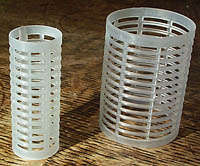
|
Usefulness - Sci-fi vehicles and scenery
Availability - Fairly Common
Sources - Chemists, department stores
 Flock
Flock

Flock is the name for loose model grass and ground textures. It is usually
attached by sprinkling onto PVA and can be fixed
more firmly with a coat of spray varnish or hairspray (although this will
tend to darken it). 'Grass' flock comes in three main varieties.
1) Chippings - Fine flakes of wood, often dyed green to look like
grass. In the old days this was the standard type, but it generally doesn't
look as good as the other two.
2) Foam Flock - This looks very similar from a distance, but close
inspection reveals it to be very finely ground up plastic foam. This type
has a softer and more natural look than the chippings. I find this type the
most useful.
3) Static Grass - These are fine fibres which can be used for bushy
clumps of grass. The fibres are all slightly different browns and greens,
which makes them more realistic.
As well as these there are also small stones and other granules in a variety
of colours to resemble stone, gravel, coal etc.
Usefulness - Texturing bases and scenery
Availability - Common
Sources - Model shops
 Spaghetti
Spaghetti

Ordinary dried spaghetti is a handy modelling material, which I'm using more and more. It's just very cheap thin rod. It doesn't
have much strength, so you need to use it glued to the face of something else, but there are still lots of situations
where it comes in handy, such as this Gothic ruin or this Vietnamese hut.
Usefulness - Adding detail to scenery
Availability - Common
Sources - Supermarkets and grocers
 Dried Tea
Dried Tea

Tea can be used as a very cheap base texture as in this example.
Alan explains:
"Being English, I'm obliged to drink tea, and my family uses tea bags.
Once a bag has been used, squeeze out the excess liquid and empty the contents
onto a baking tray and spread them out. Reason for using bag tea is that it
is finer than loose tea, and using it to make a cup of tea effectively rinses
it and removes some of the tea smell."
You can also try unbrewed tea, which is a lot darker.
Usefulness - Texturing bases and scenery
Availability - Common
Sources - Supermarkets and grocers
 Sand
Sand

Sand is very useful for giving a basic texture to a base. When sprinkled
onto PVA, it forms an extremely tough layer (it
won't moult like flock) which can be easily drybrushed. I do all my bases with
this. Make sure you don't use the orange sand used by builders for mortar, because
this contains a lot of clay and the particles are too small. A much better alternative
is sharp sand, used in concrete, which is about this colour  , and contains small stones. If the sand hasn't been bought, but found, then
you may need to clean it up a bit. First sieve it through some net
curtain material, to remove big lumps of muck. Next put it into a large
container and fill with water, the sand will sink to the bottom, vegetable matter
will float, and the small particles of dirt will be held in suspension. Pour
about half the water off the top and refill, stir the sand and then pour off
again. Repeat this until the water remains fairly clean and just nice, clean
sand is left at the bottom.
, and contains small stones. If the sand hasn't been bought, but found, then
you may need to clean it up a bit. First sieve it through some net
curtain material, to remove big lumps of muck. Next put it into a large
container and fill with water, the sand will sink to the bottom, vegetable matter
will float, and the small particles of dirt will be held in suspension. Pour
about half the water off the top and refill, stir the sand and then pour off
again. Repeat this until the water remains fairly clean and just nice, clean
sand is left at the bottom.
Usefulness - Texturing bases and scenery
Availability - Fairly Common
Sources - Building suppliers, beaches
 Coral Sand
Coral Sand

Coral sand has a pleasing range of particle sizes and also often
contains small bits of shell etc, which would add interest to sci-fi/fantasy
bases. It can be bought from most aquarium shops.
Usefulness - Texturing bases and scenery
Availability - Fairly Common
Sources - Aquarium and fish shops
 White Metal
White Metal

All figures are made out of white metal. This is a mixture of tin and lead, plus a few other minor
additives. If you are going to cast your own figures, you will need some. Casting is a difficult
process because commercially, a centrifuge is used. The metal is poured into a big spinning disc,
which throws it into the moulds held within the outside of the disc. At home, you will have to rely
on gravity, which doesn't do a very good job. Bits will be missing, and the ends of limbs tend to end
up as featureless blobs. What you might consider doing instead is approaching one of the many small
scale figure manufacturers to see if they are prepared to cast them for you. (Although you may have to
have a large number made).
Usefulness - Vital for moulding, no other uses
Availability - Rare
Sources - Mail order, some model shops
|





 One
of the most common types of foliage is reindeer lichen. This comes dyed in
a variety of colours, several greens, orangey brown and a pale cream colour.
It is a soft spongey texture, and can easily be torn into small pieces and
glued with
One
of the most common types of foliage is reindeer lichen. This comes dyed in
a variety of colours, several greens, orangey brown and a pale cream colour.
It is a soft spongey texture, and can easily be torn into small pieces and
glued with 



 A sort of synthetic cotton wool, this material is sold for lining jackets and cushions. It is very cheap - the large roll on the right, about 12" across, cost less than £1. It makes excellent clouds of smoke and can be easily coloured with paint.
A sort of synthetic cotton wool, this material is sold for lining jackets and cushions. It is very cheap - the large roll on the right, about 12" across, cost less than £1. It makes excellent clouds of smoke and can be easily coloured with paint.
